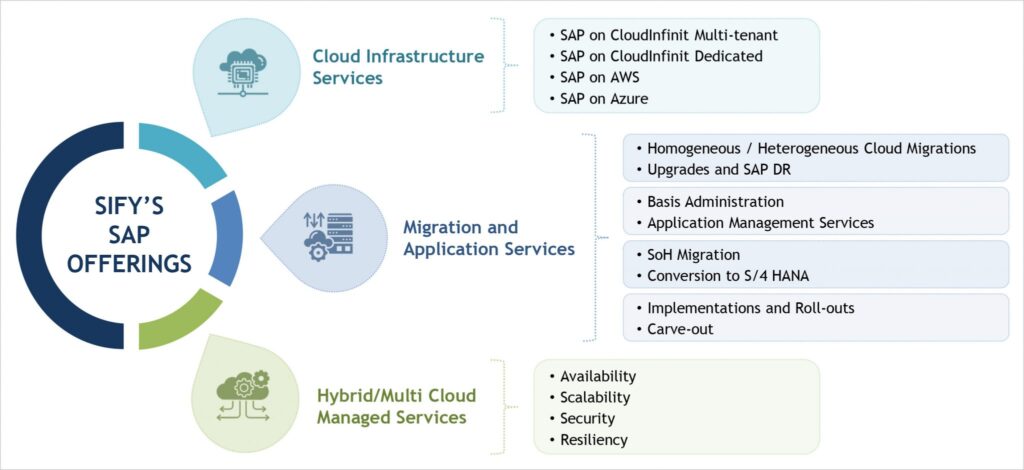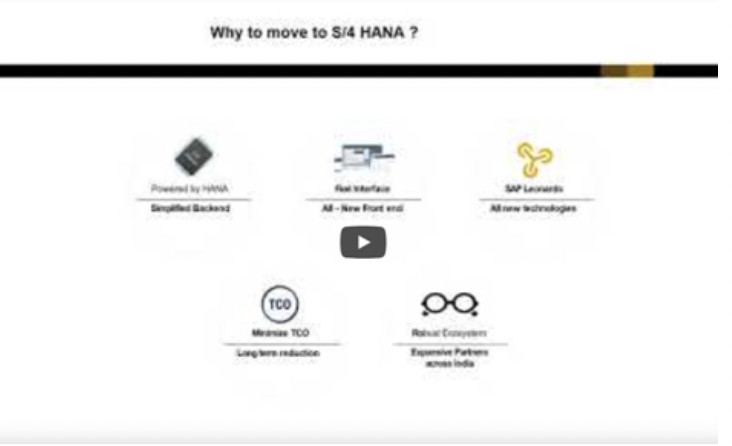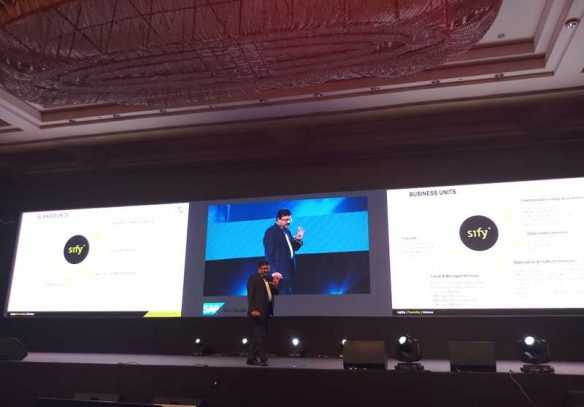Best Practices for Successful Migration to SAP S/4HANA (On-prem or Cloud)
SPEAKERS:
Prashant Pimpalekar, Sr. VP SAP Practice, Sify Technologies, will be the key speaker along with a SAP Cloud Specialist Shagun Maheshwari, Customer Solution Architect for Cloud ERP, SAP.
DATE:
17th September, 2019
TARGET AUDIENCE:
Any customer evaluating SAP S4/HANA or Cloud Migration services.
DESCRIPTION:
SAP S4/HANA brings in the agility & flexibility to leverage OLAP (On Line Analytical Processing) along with the traditional OLTP (On Line Transaction Processing), reducing data footprint by more than 1/10th.
The webinar will cover both migration options, on-premise and cloud, in detail.
SAP Partner Summit 2017
Enabling digital organizations to run simple
This is an annual flagship event for SAP partners in India, Sri Lanka and Bangladesh. The 2017 edition of the event was attended by 200 CXO participants from 120 partners across all partner categories – resell, services, build – for complete SAP solution portfolio. There were also 50 SAP senior executives from APJ region of India organization, SAP India sales leaders and channel teams.
The Agenda of the summit included the following. Apart from this, there were booth displays, on site activities and media interactions.
Welcome and Keynotes
SAP India managing director’s session
SAP APJ regional management presentation
SAP business and channels highlights and updates
Break-out Workshops
Emerging market trends and new go-to-market initiatives
Customer successes in specific SAP solutions
Fostering demand and pipe acceleration through partners
Enhancing collaboration and process efficiencies
Awards and Entertainment
External thought-leader talk
Partner awards
Entertainment night – live band
Networking over cocktails and dinner
Venue
The Renaissance, Mumbai
Date
9 Aug 2017
Organizers
SAP
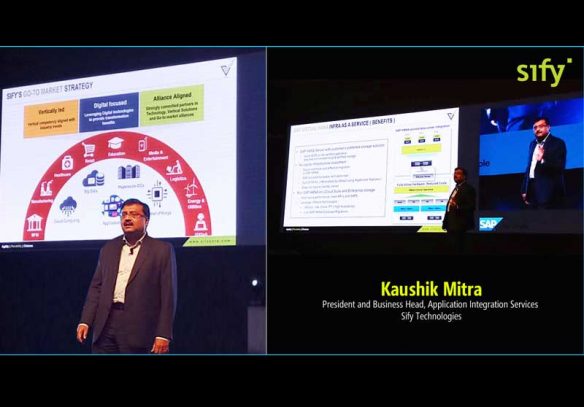
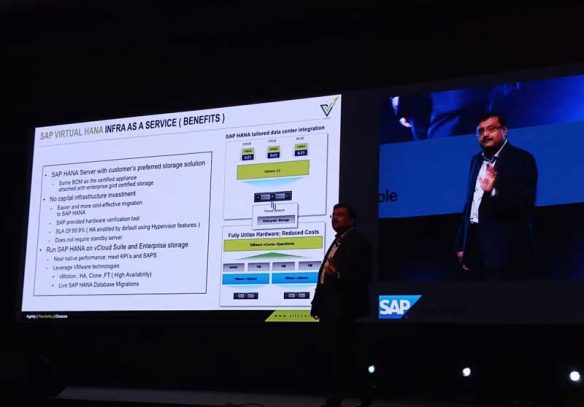
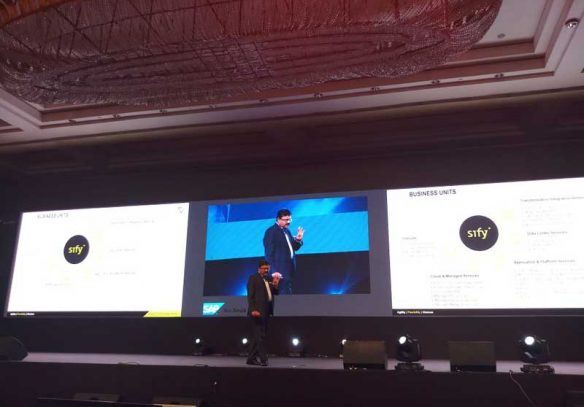
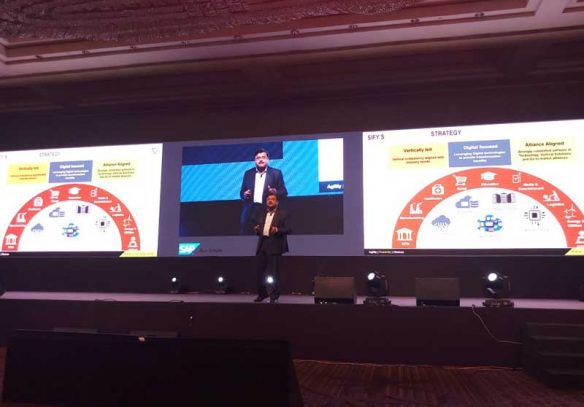
Automated Recovery of SAP HANA Database using AWS native options
This blog exclusively covers the options available in AWS to recover SAP HANA Database with low cost and without using native HSR tool of SAP. With a focus on low costs, Sify recommends choosing a cloud native solution leveraging EC2 Auto Scaling and AWS EBS snapshots that are not feasible in an on-premises setup.
Solution Overview
The Restore process leveraging Auto Scaling and EBS snapshots works across availability zones in a region. Snapshots provide a fast backup process, independent of the database size. They are stored in Amazon S3 and replicated across Availability Zones automatically, meaning we can create a new volume out of a snapshot in another Availability Zone. In addition, Amazon EBS snapshots are incremental by default and only the delta changes are stored since the last snapshot. To create a resilient highly available architecture, automation is key. All steps to recover the database must be automated in case something fails or goes wrong.
Autoscaling Architecture
The following diagram shows the Auto Scaling architecture for systems in AWS.

Use Case
EBS Snapshots
Prior to enabling EBS snapshots we must ensure the destination of log backups are written to an EFS folder which is available across Availability Zones.
Create a script prior to the command to be executed for an EBS snapshot. By using the system username and password, we make an entry into the HANA backup catalog to ensure that the database is aware of the snapshot backup. We use the snapshot feature to take a point in time and crash consistent snapshot across multiple EBS volumes without a manual I/O freeze. It is recommended to take the snapshot every 8-12 hours.
Now the log backups are stored in EFS and full backups as EBS snapshots in S3 and both sets are available across AZs. Both storage locations can be accessed across AZs in a region and are independent of an AZ.
EC2 Auto Scaling
Next, we create an Auto Scaling group with a minimum and maximum of one instance. In case of an issue with the instance, the Auto Scaling group will create an alternative instance out of the same AMI as the original instance.
We first create a golden AMI for the Auto Scaling group and the AMI is used in a launch configuration with the desired instance type. With a shell script in the user data, upon launch of the instance, new volumes are created out of the latest EBS snapshot and attached to the instance. We can use the EBS fast snapshot restore feature to reduce the initialization time of the newly created volumes.
If the database is started now (recently), it would have a crash consistent state. In order to restore it to the latest state, we can leverage the log backup stored in EFS which is automatically mounted by the AMI. Additional Care to be taken so that the SAP application server is aware of the new IP of the restored SAP HANA database server.
Benefits
- Better fault tolerance – Amazon EC2 Auto Scaling can detect when an instance is unhealthy, terminate it, and launch an instance to replace it. Amazon EC2 Auto Scaling can also be configured to use multiple Availability Zones. If one Availability Zone becomes unavailable, Amazon EC2 Auto Scaling can launch instances in another one to compensate.
- Better availability – Amazon EC2 Auto Scaling helps in ensuring the application always has the right capacity to handle the current traffic demand.
- Better cost management – Amazon EC2 Auto Scaling can dynamically increase and decrease capacity, as needed. Since AWS has pay for the EC2 instances, billing model can be used to save money, by launching instances only when they are needed and terminating them when they aren’t.
Conclusion
This blog discussed how Sify can help SAP customers to save cost by automating recovery process for HANA database, using native AWS tools. Sify would be glad to help your organization as your AWS Managed Services Partner for a tailor-made SAP on AWS Cloud solution involving seamless cloud migration experience and for your Cloud Infrastructure management thereafter.
Fast-track your SAP’s Cloud Adoption on AWS, with Sify
Cloud computing (which later became known as just Cloud), one of the technology trends since last few years, has become a game-changer. Cloud offered a platform for organizations not just to host their applications but also to maintain it / manage it and charge organizations on a pay-per-usage model. This translated into getting rid of the Capex (Capital expenditure on hardware/servers) and instead, opting for the flexible Opex (Operating Expenses) model which also helped organizations in slashing the manpower budget.
The biggest advantage of Cloud is its scalability – freedom to add/reduce storage/compute/network bandwidth as per the need within an agreed SLA-framework.
The rise of Cloud adoption led to two categories:
- Cloud as a hosting platform
- Cloud-based software/applications
Cloud as a hosting platform
This is more popularly known as Platform-as-a-Service (PaaS) or Infrastructure-as-a-Service (IaaS) wherein the service provider offers bundled services of Compute, Storage, Network & Security requirements.
Cloud providers deliver a computing platform, typically including operating system, programming language execution environment, database, and web server. Application developers can develop and run their software solutions on a cloud platform without the cost and complexity of buying and managing the underlying hardware and software layers.
Based on the deployment options, Cloud is classified under Public, Private and Hybrid Cloud, which vary due to security considerations.
Why AWS
With some PaaS providers like AWS, the underlying compute and storage resources scale automatically to match application demand so that the cloud user does not have to allocate resources manually. They use a load balancer which distributes network or application traffic across a cluster of servers. Load balancing improves responsiveness and increases availability of applications.
As per a 2020 IDC study, over 85% of customers report cost reduction by running SAP on AWS.
Get consulting support, training, and services credits to migrate eligible SAP workloads with the AWS Migration Acceleration Program (MAP).
AWS has been running SAP workloads since 2008, meaningfully longer than any other cloud provider. AWS offers the broadest selection of SAP-certified, cloud-native instance types to give SAP customers the flexibility to support their unique and changing needs.
Whether you choose to lift and shift existing investments to reduce costs, modernize business processes with native AWS services, or transform on S/4HANA, reimagining is possible with SAP on AWS.
When you choose AWS, you will be joining 5,000+ customers who trust the experience, technology, and partner community of AWS to migrate, modernize, and transform their SAP landscapes.
AWS & Sify collaboration
While AWS has been a global leader in Public Cloud services, in India Sify Technologies (one of the pioneers in the ICT domain & India’s first SSAE-16 Cloud certified provider) had designed its own Cloud called ‘CloudInfinit’ way back in 2013 and since then has been helping diverse organizations in moving their ERP applications, especially SAP workloads to its Cloud, seamlessly.
With Sify’s cloud@core strategy, customers can enjoy all facets of Cloud with complete visibility and control.
SIFY’s SAP deployment flexibility ON CLOUD

SAP on AWS hybrid cloud solutions
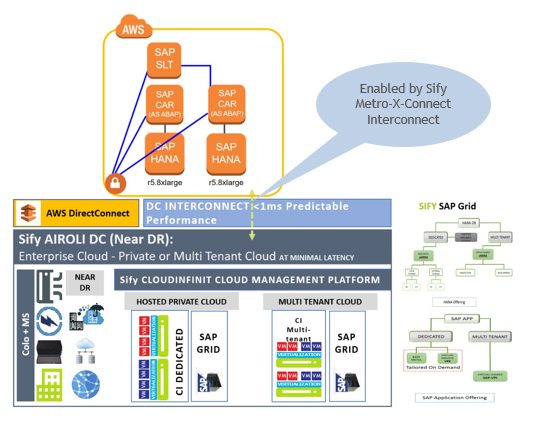
Use Cases
- Lifecycle Distribution: Separate Development and Test Environments
- Workload Distribution
- High Availability Deployments
Business Benefits
- Best of breed performance with Hybrid Cloud configuration
- Efficient integrations with extended ecosystems
- Compliance with data sovereignty
- Business continuity with resilience
- Simplicity with self service
- Operational efficiency with reduced IT administration
- Cost reduction with on-demand bursting to public clouds
Migration methodology
For SAP Migrations from on-premises or from any other Cloud to AWS, depending on various parameters like Prod. database size, available downtime window, source/target operating system/database, connectivity/link speed etc., we have been using various ways for seamless migration briefly explained below.

SAP SYSTEMS monitoring
Once SAP workloads are moved to AWS, Sify’s Managed Services takes care of every aspect, including monitoring the Operating System, Database, Connectivity, Security, Backup etc. as per the agreed SLAs. It also monitors the mission-critical SAP systems closely as depicted in diagram below.

Conclusion
Cloud, the scalable, flexible and yet robust hosting platform allows you to use your ERP workloads as well as SaaS applications effectively. Going by the increasing number of customers moving to Cloud, it is certain that Cloud is not vaporware, it is here to stay and only to grow bigger and safer by the day! It would also necessitate organizations to chart out a Smart Cloud strategy.
Simplified Cloud Adoption for SAP S/4HANA
Let Sify, your Cloud expert manage your SAP Migration

Every transformation journey begins with adoption of digital technologies on Cloud. Forward-looking organizations worldwide are looking for Cloud-powered solutions to attain the highest level of business agility, scalability, and compliance in the most cost-effective way. Additionally, Cloud-powered solutions facilitate access to new generation technologies, such as IoT, AI, and ML, which help you achieve your transformation goals in an outcome-focused manner.

SAP S/4HANA is a modern business solution suite that fosters intelligent innovations, business process improvement, and IT landscape transformation, without any upfront capital investment in infrastructure, database, hardware, etc. Moreover, it comes with pervasive data modelling capabilities and simplified deployment roadmap options.
Cloud adoption for SAP S/4HANA
Powered with Cloud and Analytics, SAP S/4HANA is undoubtedly a comprehensive, intelligent business suite delivering to organizations, unique insights, and intelligence. However, moving to SAP S/4HANA is not as simple as it may seem initially. It is dependent on your insight and capability to fundamentally examine your business processes, infrastructure, and data. Furthermore, you need to reconsider your business objectives and project priorities to achieve seamless migration to Cloud and realize all its benefits.
To evaluate how SAP S/4HANA can benefit your organization, it is always sensible to assess the consumption and configuration of your existing SAP environment. Subsequently, you need to create a migration to Cloud roadmap for seamless technical deployment, depending on project specific requirements, strategic transformation goals, etc.
Irrespective of the approach you choose, be it New Implementation or System Conversion, there are various advisory tools, such as Business Scenario Recommendations, Readiness Check Tool, etc. that can help you gain the necessary insight and confidence to simplify your move to SAP S/4HANA. After gaining clarity, you should continue forward with your S/4HANA adoption on Cloud in a phase-driven manner.
Five phases of successful SAP S/4HANA Cloud journey

Re-evaluate your current stage and develop a vision:
Before you start your Cloud journey, answer the reasons behind it. You need to evaluate your current IT landscape, analyze your business strategy, consider cross-functional dependencies, and develop a strategic vision before moving to SAP S/4HANA. Herein, Business Scenario Recommendations (BSR) for SAP S/4HANA can help you generate a comprehensive report on how your current system would be impacted and how you should prepare adeptly to derive true value propositions.

Explore the value of SAP S/4HANA:
Once you have evaluated your business landscape, you must start exploring all the value propositions of SAP S/4HANA that can help you transform the overall IT landscape and improve business processes. Mapping key business functions is yet another major area you need to consider while analyzing the values of SAP S/4HANA. SAP Innovation & Optimization Pathfinder can help you analyze all the business improvement opportunities. It also provides rich analysis of innovation recommendations, innovation acceleration, and IT optimization.

Future State Design:
During this phase, you need to start focusing on the technical aspects of your migrating specific parts of your IT landscape or processes to SAP S/4HANA. It is always advisable to define processes and IT landscape that you think are suitable for SAP S/4HANA in order to devise a future-ready migration layout. During this phase, organizations count on different tools such as Readiness Check and Maintenance Planner. Readiness Check highlights the required solution adjustments that are needed for system conversion. Maintenance Planner generates the stack file online from SAP marketplace, which is required to download the SAP S/4HANA software.

Migration and roadmap:
Before the transition begins, you need to outline clearly defined migration strategies to identify, evaluate and select the best migration scenario. To attain seamless transformation and successful SAP S/4HANA migration, you must define the strategy that best suits your vision depending on your current IT stage.

Plan S/4HANA Implementation:
The actual transition begins in this phase, and you must embrace a high-level project management approach to successfully migrate to SAP S/4HANA. As majority of organizations lack technical skill, competence, and expertise to implement such a project, it makes good business sense to collaborate with an expert.
Why Sify for SAP migration, infrastructure, and management?
It is important not to get overwhelmed by the adoption complexity, as finding the right partner will alleviate most of your concerns. Sify has a rich experience and all the state-of-the-art tools required for successfully migrating heterogeneous or homogeneous SAP workloads and managing them.
Sify provides you the option of choosing the most appropriate environment for your SAP workloads. You can host your SAP workloads on HANA grid (which is certified by SAP) on Sify’s proprietary Cloud – CloudInfinit. You also have the choice of deploying it on a Hyperscaler (AWS, Azure, etc.) with DR on Sify’s SAP grid or vice versa to leverage the benefits of Hybrid Cloud. Furthermore, we hold a distinct level of specialization in ECC to S/4HANA conversions, implementation and carve out scenarios. Sify’s integrated play across Network, Cloud and SAP ensures that you get flexibility, agility, and choice for comprehensive coverage of all your SAP needs.
Snapshot of Sify’s SAP offerings
